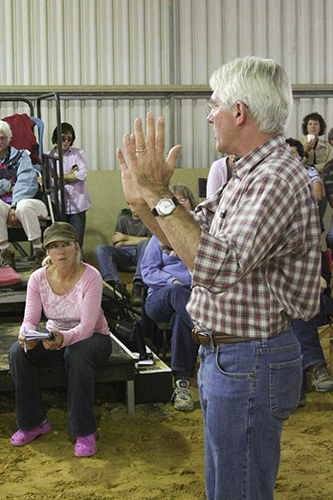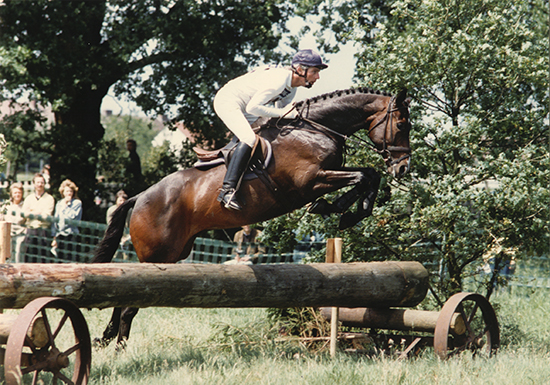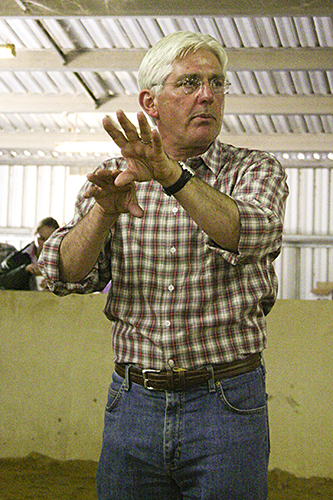 I have a friend, Caroline Plewa. Who? You might ask – or so? You might think.
I have a friend, Caroline Plewa. Who? You might ask – or so? You might think.
Well Caroline is the daughter of Martin Plewa. Martin was the German national eventing coach from 1984 till 2000 and is an international dressage judge, in fact he was on the ground jury for the eventing at last years World Championships in Aachen. Caroline has been studying here in Adelaide for a number of years now and is staying here to work, so her whole family came out to see her over Christmas. The EFA SA took the opportunity to organize a coaches and judges clinic/forum with Martin that went for three days.
It was a very simple clear clinic. Martin has a very good way of teaching and communicating, even if his English is a little broken. We started the first day with lunge lessons and how to use this affectively to actually improve the rider. Firstly the instructor must stand outside the circle in order to accurately assess the rider, therefore you need a lunger to lunge the horse for the instructor.
The purpose of lunging is not to go round and round with no stirrups until the rider can’t hold on any more, in fact Martin doesn’t like taking away the stirrups until the rider is in real balance and is supple. They start with stirrups and no reins.
He uses the lunging to create suppleness and mobility in the rider, as without these qualities the rider will find it hard to balance and ultimately ride with the correct position. The rider on the lunge was asked to do many stretches and movements with their arms, legs, ankles, neck and body. Every time the rider did a movement with any part of their body their seat bones were not allowed to leave the saddle. And they were not to disturb the horse’s rhythm while doing the movements.
The best way to improve balance is to be consistently put out of balance and have to regroup in a controlled way using the inner core of the body. These lunge exercises allow for this. The stirrups are kept on the short side as it is easier to stand up in shorter stirrups and this exercise naturally puts the leg in a position with the heel under the hip, and flexion in the ankle. This is the start of the correct position. Martin is not a fan of forcing the rider to ride in the correct position until they are supple and balanced, then the correct position develops as a result of this.
Once the rider could sit balanced on the horse, there were the co ordination exercises and the inevitable transitions using weight aids, all still on the lunge. Riders were asked to move their hands in different ways in time with – say – the trot every stride – or every third stride. This way the rider had to really feel the horse’s rhythm and co-ordinate themselves with the horse. There was also the effect of the jockey length stirrups, riding this short, sitting in the saddle really makes you sit on your seat bones, as they are the only thing left on the saddle. Also standing in these very short stirrups is very good for general balance.
Martin also likes to lunge the riders with just a vaulting roller and blanket, as this really allows the rider to feel the horse. He stressed that for the lunging to be effective you need a balanced educated lunge horse so the rider has a good feel from the start.
Then the riding lessons started, these were really good to watch. No matter who was riding or what level horse they were on, he was absolutely not going to let anyone even walk around with the horse behind the vertical or too low in the poll.
He asked each rider to just walk around on a totally long rein to give him an impression of the natural overtrack of the horse and its natural frame. The riders had to use correct driving forward aids to maintain a good quality walk and good overtrack while the horse stretched its neck out and slightly down. If a horse was inclined at all to roll over at the poll and drop the contact the riders had to use half halts through their body and driving forward leg aids but no rein. This would then affectively push the horse’s head and neck out from the dark side of being behind the vertical and back into the stretching forward contact.
Then the riders could start to take up their reins, but if the horses lost any quality of the walk they had to give the rein again, and drive forward again – then repeat this over and over until the horse remained in a good walk and quality contact.
Then they could go forward to trot and start the millions of transitions and changes of rein needed to make the horse supple. If you know your horse has a better canter than trot, then use more transitions from trot to canter and canter to trot than walk / trot transitions and visa versa.
What was interesting was that he did no lateral work to supple the horses, just simple changes of rein, changes of circle size to suit the horse’s level of education and changes of pace and frame. All the time the horse remained with his neck stretching forward. Even when the frame came higher, the rider was not to shorten the neck to do this, just lots of half halts. He made many of the riders do this with their reins in one hand so they couldn’t pull during the half halt; they had to use their seat and legs only into the reins. The riding with one rein really helped a lot of the horses that were inclined to roll over. It also helped the riders riding downward transitions get the idea of starting the new pace not finishing the pace they were in. They rode with more leg to the single hand on the rein and the horses started to carry their riders much better.
Once these more experienced riders and horses were warmed up and the frame was correct they could start exercises to prepare the lateral work. They had to be able to ride flexion and bend on the inside track and not lose the hind quarters to the outside track, before they could ride a shoulder fore, then they could ride the shoulder in. Everything was progressive so the horse was never unsure of what was being asked.
Then there were the horses and riders that were a little greener and the combination didn’t have any connection in the first place. As coaches we see a lot of these. Martin would halt these horses and help the rider get the feel they need by holding the reins himself at the halt and asking the rider to drive the horse forward into his non-allowing contact on the outside rein while he just flexed the horse a little with the inside rein. This way the rider didn’t have a chance to “pull and kick and cause more problems”. Then rider would then walk forward with Martin still attached to the reins so he could let the riders feel the kind of contact he had with the horse.
This would be the same in trot and canter and through transitions, he was quite talented at it, and it really worked, the riders then had a good feel and they were confident to drive the horse forward into the reins rather than just pull its head down. The horses were also not behind the vertical.
Once these riders had this level of coordination of leg to reins, they were sent out to do many large circles and changes of rein and pace. These were the main exercises to supple the horses – not pulling their necks around and kicking them sideways like you see so often. They did many transitions, changes of rein, changes of frame and learnt to bend the horse from the inside leg – not just pull its head to the inside.
The riders had to use their outside leg to keep the horse coming around the circle and around their long inside leg. Using the outside rein as the guiding rein then allowed the rider to push the horse from the inside girth area to the outside shoulder, thus creating a gentle bend in the horse’s whole body.
They were not allowed to let the horse just bend its neck and fall out through the outside rein. If there was any crookedness they had to just use driving aids to drive the horse forward to the outside rein again with a little outside flexion to straighten the horse.
Martin was clear that the outside rein can be used in a downward feel to the horse’s wither to create almost a side rein feel for the horse, so the rider only pulls down, and not back. So if needed, the rider just holds the saddlecloth on the outside to keep the rider’s hand from pulling back. The rider can also hold the saddlecloth to get the feeling of giving a half halt into the outside rein without it pulling back. The inside hand always thinks forward and can ask flexion by flexing the wrist only, or with a slightly raised position to help with the flexion, then it allows, but maintains a contact, as soon as the horse responds. And of course the leg must be there to support the rein aids that are given.
Then there was leg yield… well actually Martin thinks it’s a exercise that is done only to teach new rider the diagonal aids or the green horse the diagonal aids and it’s only to be done from the quarter line to the out side track never on a circle. He said leg yielding on the circle teaches the horse to escape the inside leg which then makes doing shoulder in really hard, because it ends up doing a leg yield on the long side.
So even though he said he basically never uses leg yield, he had to with one student because the horse didn’t understand to move from the inside leg at all. So Martin was strict with his principles, but very flexible with each horse’s needs.
He spoke of the training scale but kept everything very simple. I could go on for pages with the good exercises and his many comments… One thing I will say he is very very passionate about the idea that the reins are to stop and the legs to go. He absolutely disagrees with the concept that there must be a co ordination of all aids together. He was also firm that the horse must be allowed and trained to use its neck in the correct way.
Martin Plewa was a pleasure to watch teach. He did no tricks. He just pretty much delivered the same principles, 8 hours a day for 3 days, never giving up and being very strict with the riders’ leg and weight aids, these were the most important. He was also strict that their hands stayed still so the horse had a clear feeling in the reins. Your hands give you information of what the horse is doing, you will feel if he is hollow or behind the vertical. However you don’t fix what is happening in the horse’s body with your hands. You drive them into the hand, you half halt into the hand, you allow within the contact.
I could go on and on but I won’t, but what I will say is if Martin Plewa comes to your State, do go and watch you’ll learn a lot, you will have your own ideas confirmed, or maybe totally change the way you think about training. South Australia will be holding Caroline hostage to ensure Martin returns to see her and we can get another clinic with him and I know WA are keen to have him back also.
My New Year’s resolution… never behind the vertical again.
Photos: www.inmotionphotography.net
This article originally appeared in THM March 2007.

